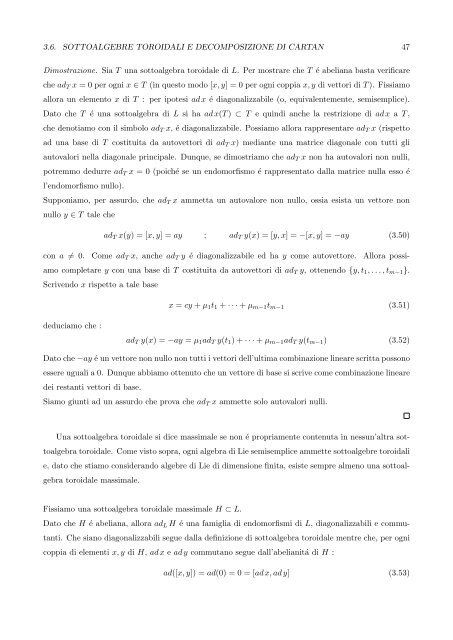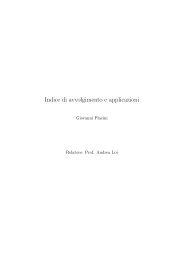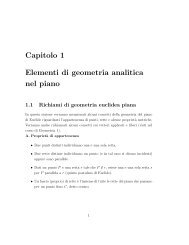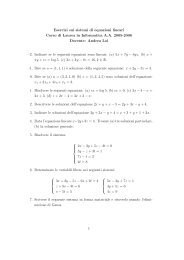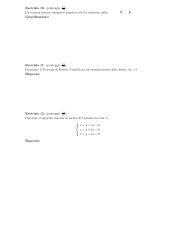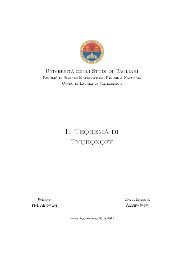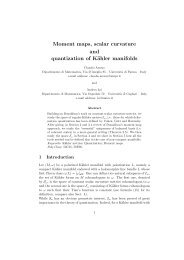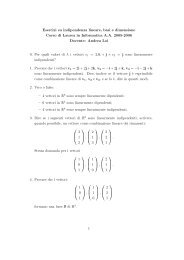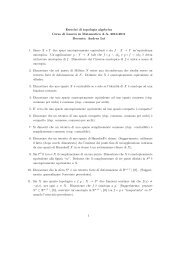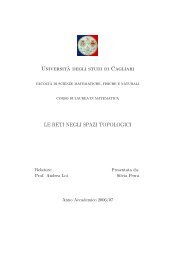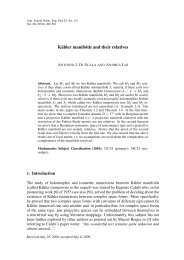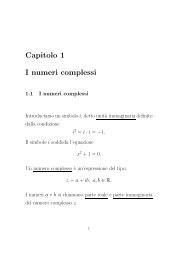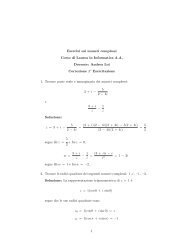Algebre di Lie semisemplici, sistemi di radici e loro classificazione
Algebre di Lie semisemplici, sistemi di radici e loro classificazione
Algebre di Lie semisemplici, sistemi di radici e loro classificazione
You also want an ePaper? Increase the reach of your titles
YUMPU automatically turns print PDFs into web optimized ePapers that Google loves.
3.6. SOTTOALGEBRE TOROIDALI E DECOMPOSIZIONE DI CARTAN 47<br />
Dimostrazione. Sia T una sottoalgebra toroidale <strong>di</strong> L. Per mostrare che T é abeliana basta verificare<br />
che adT x = 0 per ogni x ∈ T (in questo modo [x, y] = 0 per ogni coppia x, y <strong>di</strong> vettori <strong>di</strong> T ). Fissiamo<br />
allora un elemento x <strong>di</strong> T : per ipotesi ad x é <strong>di</strong>agonalizzabile (o, equivalentemente, semisemplice).<br />
Dato che T é una sottoalgebra <strong>di</strong> L si ha ad x(T ) ⊂ T e quin<strong>di</strong> anche la restrizione <strong>di</strong> ad x a T ,<br />
che denotiamo con il simbolo adT x, é <strong>di</strong>agonalizzabile. Possiamo allora rappresentare adT x (rispetto<br />
ad una base <strong>di</strong> T costituita da autovettori <strong>di</strong> adT x) me<strong>di</strong>ante una matrice <strong>di</strong>agonale con tutti gli<br />
autovalori nella <strong>di</strong>agonale principale. Dunque, se <strong>di</strong>mostriamo che adT x non ha autovalori non nulli,<br />
potremmo dedurre adT x = 0 (poiché se un endomorfismo é rappresentato dalla matrice nulla esso é<br />
l’endomorfismo nullo).<br />
Supponiamo, per assurdo, che adT x ammetta un autovalore non nullo, ossia esista un vettore non<br />
nullo y ∈ T tale che<br />
adT x(y) = [x, y] = ay ; adT y(x) = [y, x] = −[x, y] = −ay (3.50)<br />
con a = 0. Come adT x, anche adT y é <strong>di</strong>agonalizzabile ed ha y come autovettore. Allora possi-<br />
amo completare y con una base <strong>di</strong> T costituita da autovettori <strong>di</strong> adT y, ottenendo {y, t1, . . . , tm−1}.<br />
Scrivendo x rispetto a tale base<br />
deduciamo che :<br />
x = cy + µ1t1 + · · · + µm−1tm−1<br />
(3.51)<br />
adT y(x) = −ay = µ1adT y(t1) + · · · + µm−1adT y(tm−1) (3.52)<br />
Dato che −ay é un vettore non nullo non tutti i vettori dell’ultima combinazione lineare scritta possono<br />
essere uguali a 0. Dunque abbiamo ottenuto che un vettore <strong>di</strong> base si scrive come combinazione lineare<br />
dei restanti vettori <strong>di</strong> base.<br />
Siamo giunti ad un assurdo che prova che adT x ammette solo autovalori nulli.<br />
Una sottoalgebra toroidale si <strong>di</strong>ce massimale se non é propriamente contenuta in nessun’altra sot-<br />
toalgebra toroidale. Come visto sopra, ogni algebra <strong>di</strong> <strong>Lie</strong> semisemplice ammette sottoalgebre toroidali<br />
e, dato che stiamo considerando algebre <strong>di</strong> <strong>Lie</strong> <strong>di</strong> <strong>di</strong>mensione finita, esiste sempre almeno una sottoal-<br />
gebra toroidale massimale.<br />
Fissiamo una sottoalgebra toroidale massimale H ⊂ L.<br />
Dato che H é abeliana, allora adL H é una famiglia <strong>di</strong> endomorfismi <strong>di</strong> L, <strong>di</strong>agonalizzabili e commu-<br />
tanti. Che siano <strong>di</strong>agonalizzabili segue dalla definizione <strong>di</strong> sottoalgebra toroidale mentre che, per ogni<br />
coppia <strong>di</strong> elementi x, y <strong>di</strong> H, ad x e ad y commutano segue dall’abelianitá <strong>di</strong> H :<br />
ad([x, y]) = ad(0) = 0 = [ad x, ad y] (3.53)


